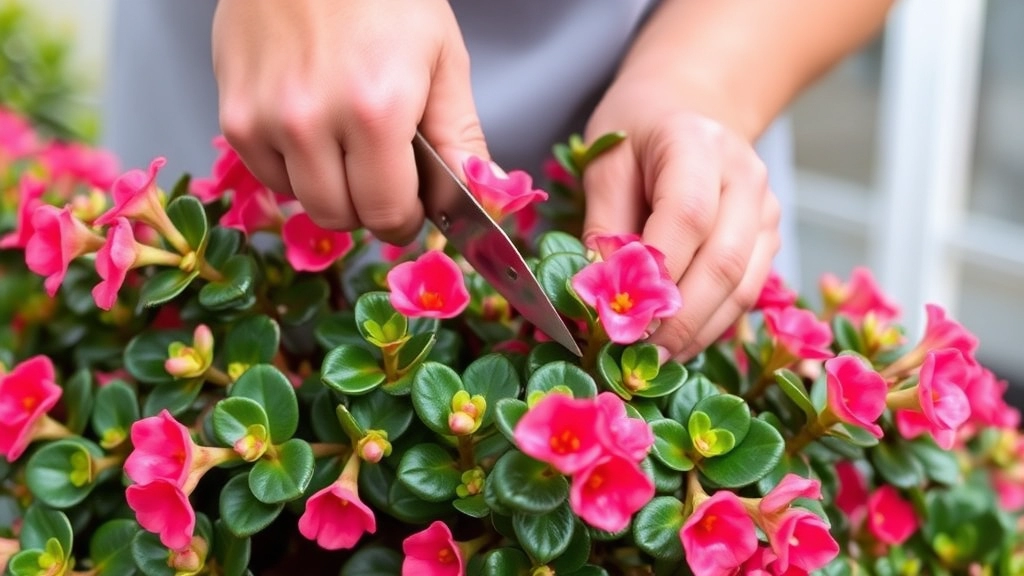Pruning Your Kalanchoe
Pruning your Kalanchoe is essential for keeping it healthy and promoting lush growth. Knowing when to prune can make all the difference. Generally, the best time to prune is after the blooming season, ensuring your plant has time to recover and thrive.
Getting Started
To get started, you’ll need a few basic tools. A pair of sharp pruning shears, some disinfectant, and a clean cloth will do the trick. With these tools in hand, you’re ready to give your Kalanchoe the care it deserves.
When to Prune Kalanchoe for Optimal Growth
Have you ever wondered when is the best time to prune your Kalanchoe?
Timing is crucial for ensuring optimal growth and health in these vibrant succulents.
Tools Needed for Effective Kalanchoe Pruning
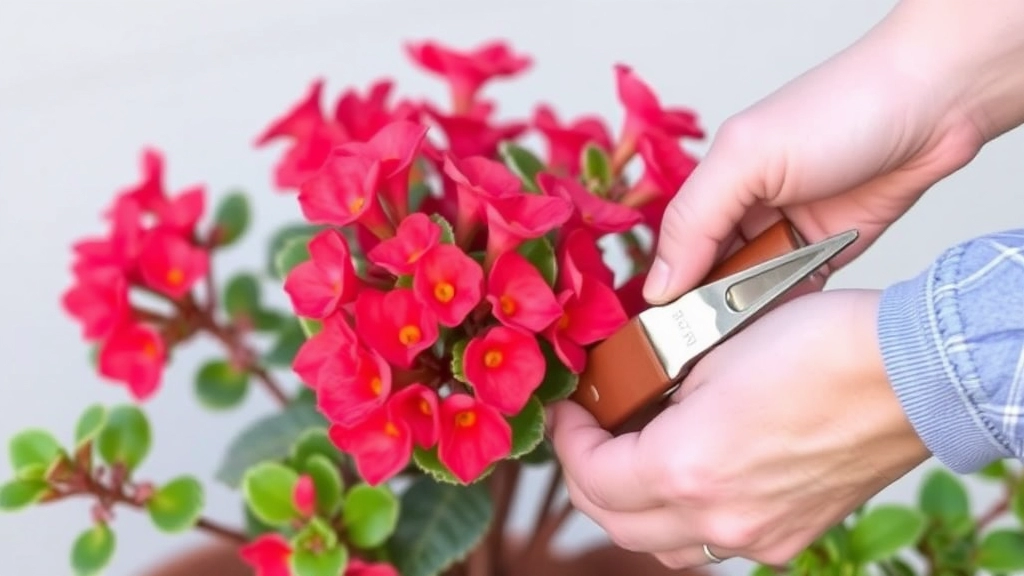
So, you’re ready to dive into pruning your Kalanchoe?
Before you grab those scissors, let’s chat about the tools you’ll need to make this task smooth and effective.
Having the right tools not only makes the job easier but also ensures your plant stays healthy and thrives. Here’s what you’ll want to have on hand:
- Sharp Pruning Shears: A good pair of sharp shears is a must. Dull blades can crush stems rather than cut cleanly, which can lead to disease.
- Gloves: While Kalanchoes aren’t overly prickly, it’s always smart to wear gloves to protect your hands from any sap or irritants.
- Disinfectant: A simple rubbing alcohol or bleach solution will do. Clean your tools before and after pruning to prevent spreading any potential diseases.
- Small Trowel: If you’re working with offsets or repotting after pruning, a small trowel can help you maneuver around the roots without causing damage.
- Container for Cuttings: Have a small pot or container ready if you plan to propagate from your pruned cuttings.
- Watering Can: After pruning, your Kalanchoe might need a little hydration, so keep a watering can nearby.
Step-by-Step Guide to Pruning Kalanchoe Stems
Pruning Kalanchoe can feel daunting, especially if you’re unsure where to start. However, with a clear step-by-step guide, you can confidently enhance your plant’s health and appearance.
1. Assess Your Plant
Before you begin, take a moment to evaluate the overall health of your Kalanchoe. Look for:
- Leggy stems that need shortening
- Overgrown areas that require shaping
- Dead or wilting leaves and flowers that should be removed
2. Gather Your Tools
Having the right tools on hand makes the process smoother. You will need:
- Sharp, clean pruning shears or scissors
- Gloves to protect your hands
- Disinfectant to clean your tools before and after use
3. Choose the Right Time
Timing is crucial when it comes to pruning Kalanchoe. The best times are:
- Spring: After flowering, to encourage new growth.
- Early summer: For maintenance pruning.
4. Start Pruning
Follow these steps to prune effectively:
- Identify the stems that need cutting. Look for those that are leggy or have dead flowers.
- Cut at an angle just above a leaf node. This encourages new growth.
- Remove any dead leaves at the base of the plant.
5. Clean Up
After pruning, ensure you:
- Dispose of cuttings properly to prevent disease.
- Clean your tools to avoid contaminating other plants.
6. Monitor Growth
After pruning, keep an eye on your Kalanchoe. You should notice:
Pinching Back Stems to Promote Bushier Growth
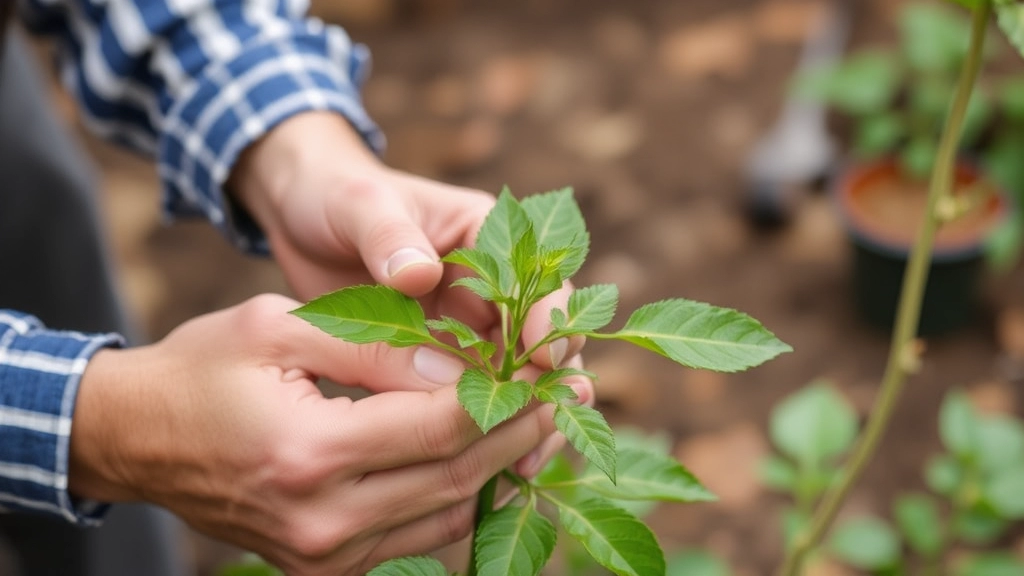
Are you noticing that your Kalanchoe is growing tall and leggy rather than lush and full?
Pinching back stems is a fantastic way to encourage bushier growth in your Kalanchoe. This simple technique not only helps maintain a compact shape but also promotes the development of side shoots, giving your plant a fuller appearance.
Here’s how to effectively pinch back your Kalanchoe:
- Timing: Aim to pinch back stems in the spring or early summer when the plant is actively growing.
- Identify Stems: Look for the main stems that have grown excessively long. These are the ones you’ll want to focus on.
- Pinching Technique:
- Use your fingers to pinch off the stem just above a leaf node.
- Ensure you’re not cutting too low; leaving a few leaves will stimulate new growth.
- Frequency: Repeat this process every few weeks during the growing season to maintain bushiness.
- Observe Growth: After a few weeks, you should start to see new side shoots emerging, enhancing your plant’s fullness.
By pinching back the stems, you not only create a more attractive plant but also encourage healthier growth overall.
Deadheading Kalanchoe Flowers for Continuous Bloom
Have you ever noticed that your Kalanchoe flowers start to wilt and fade? This can be disheartening, especially when you want your plant to thrive and produce vibrant blooms throughout the season.
Deadheading is a crucial practice that can rejuvenate your Kalanchoe, promoting continuous blooming and keeping your plant looking its best.
What is Deadheading?
Deadheading involves removing spent flowers from the plant. This process not only improves the aesthetic appeal but also encourages the plant to redirect its energy towards producing new blooms.
When to Deadhead Your Kalanchoe
- Timing: Ideally, deadhead your Kalanchoe as soon as the flowers begin to wilt. This ensures that the plant does not waste energy on maintaining dying blooms.
- Frequency: Regularly check your plant every few weeks during the blooming season to remove any faded flowers.
How to Deadhead Kalanchoe Flowers
- Gather Your Tools: You’ll need clean, sharp scissors or pruning shears.
- Identify Spent Flowers: Look for flowers that have lost their vibrancy or are starting to dry out.
- Make the Cut:
- Cut the stem just above the first set of healthy leaves.
- This encourages new growth and prevents any potential disease from settling in.
- Dispose of the Cuttings: Ensure you discard the spent flowers away from the plant to avoid attracting pests.
Benefits of Deadheading
- Promotes New Growth: By removing old flowers, you encourage the Kalanchoe to produce fresh blooms.
- Enhances Appearance: A tidy plant with no wilted flowers looks more appealing.
- Prevents Disease: Removing dead flowers helps reduce the risk of fungal infections and pests.
For more detailed tips on maintaining your Kalanchoe, you can refer to the best tips and techniques for pruning Kalanchoe plants. Additionally, if you’re interested in different varieties, check out our guide on Kalanchoe Tomentosa varieties and care tips.
Managing Leggy Kalanchoe Stems through Pruning
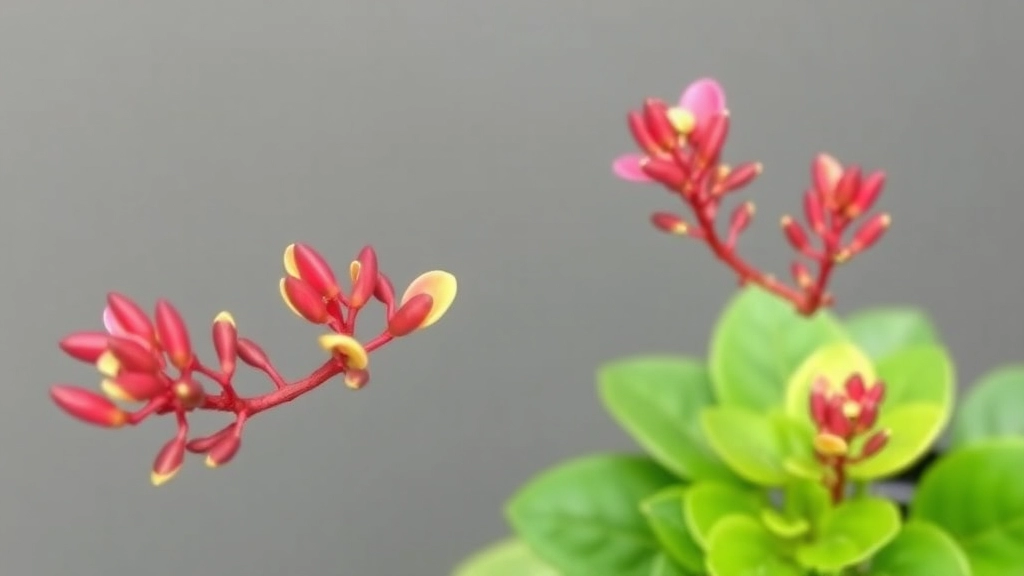
Ever looked at your Kalanchoe and thought, “Why is it so leggy?” If your plant is stretching awkwardly towards the light, it’s time to take action. Leggy stems not only look unappealing, but they can also hinder your plant’s overall health.
Why Kalanchoe Becomes Leggy
- Insufficient Light: Kalanchoes thrive in bright, indirect sunlight. If they’re not getting enough light, they’ll stretch to find it.
- Overwatering: Too much water can lead to weak stems that can’t support the plant’s growth.
- Lack of Pruning: Regular pruning helps maintain a bushy shape.
How to Prune Leggy Stems
- Identify the Problem Areas: Look for stems that are excessively long and thin.
- Use Clean Tools: Grab your sharp, clean scissors or pruning shears.
- Cut Back Wisely: Trim the leggy stems back to a healthy leaf node. This encourages new growth from that point.
- Be Bold: Don’t be afraid to remove up to a third of the plant if needed. It’ll thank you for it!
Post-Pruning Care
- Adjust Lighting: Move your Kalanchoe to a brighter spot to prevent future legginess.
- Water Wisely: Ensure you’re not overwatering. Let the soil dry out between waterings.
- Fertilize: A balanced fertilizer can help promote bushier growth after pruning.
Addressing Common Pruning Mistakes for Kalanchoe
When it comes to pruning Kalanchoe, even seasoned gardeners can make mistakes. These missteps can hinder the plant’s growth and overall health. Let’s explore some common pitfalls and how to avoid them.
1. Pruning at the Wrong Time
Timing is crucial.
- Avoid pruning during dormancy. Kalanchoe typically goes dormant in winter. Pruning during this time can stress the plant.
- Best time to prune is in spring. This encourages new growth as the plant wakes up.
2. Over-Pruning
Less is often more.
- Cutting too much can weaken the plant. Aim to remove only 20-30% of the foliage.
- Focus on unhealthy or leggy stems. This helps maintain a balanced shape without sacrificing health.
3. Using Dull Tools
Sharp tools make a difference.
- Always use clean, sharp scissors or pruning shears. This minimizes damage and reduces the risk of disease.
- Disinfect your tools. A simple solution of rubbing alcohol can prevent the spread of pathogens.
4. Ignoring the Plant’s Natural Shape
Every plant has its own character.
- Avoid making random cuts. Observe the plant’s natural growth pattern before pruning.
- Shape the plant gently. This promotes a more natural appearance and encourages bushier growth.
5. Neglecting Post-Pruning Care
What you do after pruning matters.
- Water the plant lightly. This helps it recover without overwhelming it.
- Avoid fertilising immediately. Wait a few weeks to let the plant adjust.
For more detailed care tips, you might find our guide on how to care for a Kalanchoe succulent useful. Additionally, if you’re dealing with specific varieties, our Kalanchoe tomentosa care guide offers in-depth information on maintaining healthy growth.
Pruning Offsets to Encourage Mother Plant Health
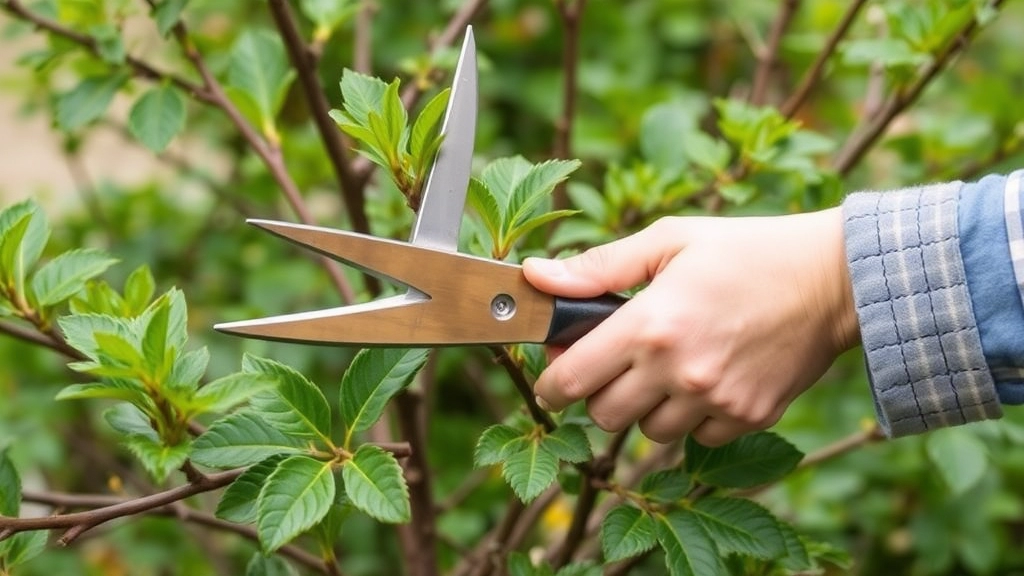
Have you ever noticed those little offsets popping up around your Kalanchoe?
These adorable little babies can steal nutrients from the mother plant if left unchecked.
So, let’s dive into why pruning offsets is essential for keeping your Kalanchoe thriving.
Why Prune Offsets?
- Nutrient Boost: By removing offsets, you allow the mother plant to focus its energy on growing stronger and healthier.
- Space Management: Too many offsets can crowd your plant, leading to poor air circulation and increased risk of disease.
- Aesthetic Appeal: A well-pruned Kalanchoe looks more polished and vibrant.
How to Prune Offsets
- Identify Offsets: Look for small rosettes that have developed around the base of your mother plant.
- Use Clean Tools: Grab your sharp, clean scissors or pruning shears. This helps prevent any infection.
- Cut Carefully: Gently cut the offset away from the mother plant, ensuring you don’t damage the roots or the main stem.
- Leave a Bit of Stem: Try to leave a small piece of stem attached to the offset for better rooting if you plan to propagate it.
- Clean Up: Remove any dead leaves or debris around the base to keep things tidy.
After Pruning
- Watering: Give your Kalanchoe a light watering after pruning to help it recover.
- Light: Ensure it gets plenty of bright, indirect sunlight to promote healthy growth.
How to Propagate Kalanchoe from Pruned Cuttings
After pruning your Kalanchoe, you may wonder how to make the most of those cuttings. Propagating Kalanchoe from pruned cuttings is not only rewarding but also a fantastic way to expand your plant collection.
Why Propagate?
Many plant enthusiasts face the dilemma of wanting more plants without spending a fortune.
- Cost-effective: Propagating from cuttings saves money.
- Sentimental value: You can keep a piece of your original plant.
- Sharing: Gift cuttings to friends and family.
Steps for Propagation
- Choose Healthy Cuttings: Select stems that are healthy and free from disease. Aim for cuttings that are around 3-4 inches long.
- Let Cuttings Callous: Place the cuttings in a dry, shaded area for a few days. This allows the cut ends to callous over, reducing the risk of rot.
- Prepare the Soil: Use a well-draining potting mix. A combination of cactus mix and perlite works wonders.
- Plant the Cuttings:
- Make small holes in the soil.
- Insert the cuttings about an inch deep.
- Space them out to allow for growth.
- Water Sparingly: After planting, lightly water the soil. Avoid overwatering, as this can lead to rot.
- Provide Ideal Conditions:
- Place the pot in a bright, indirect light location.
- Maintain a warm temperature, ideally between 20-25°C.
- Monitor Growth: In a few weeks, you should see new growth. This indicates successful rooting.
Common Issues
- Rotting: Ensure cuttings are not too wet.
- Leggy Growth: If cuttings stretch towards the light, they may need more light exposure.
By following these steps, you’ll be well on your way to propagating Kalanchoe successfully. For more detailed information on propagating Kalanchoe Blossfeldiana and other varieties, you can explore our comprehensive Kalanchoe species list.
Post-Pruning Care Tips for Kalanchoe Plants
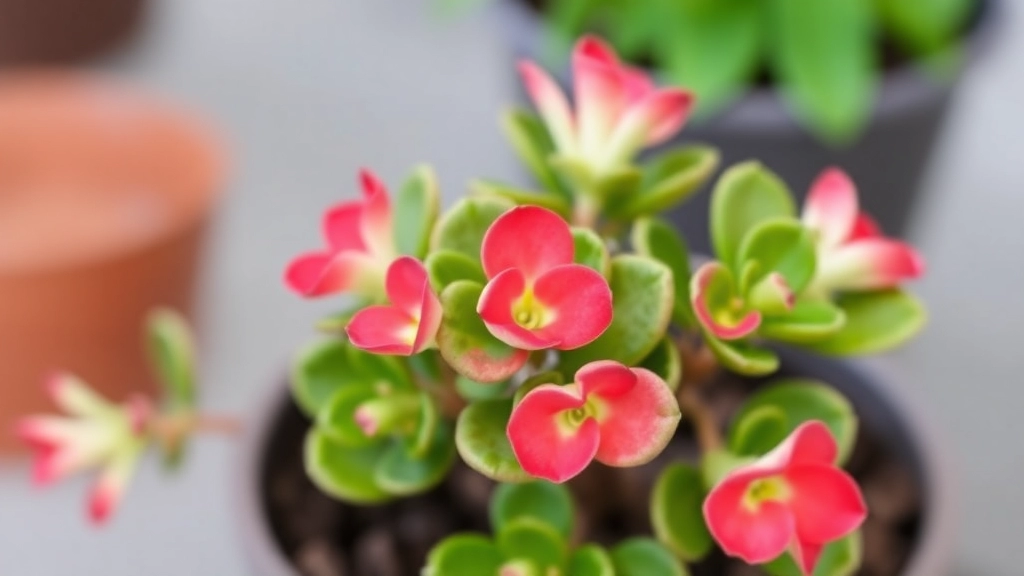
So, you’ve just pruned your Kalanchoe. Great job! But what happens next?
After pruning, your plant needs a little extra love to bounce back and thrive. Here are some straightforward tips to ensure your Kalanchoe stays healthy and happy:
- Water Wisely:
- Wait a few days after pruning before watering.
- This helps the plant recover from any stress and prevents root rot.
- Light it Up:
- Place your Kalanchoe in bright, indirect sunlight.
- Avoid direct sunlight for a week or so; it can be a bit too intense post-pruning.
- Temperature Check:
- Keep your plant in a warm spot, ideally between 18-24°C.
- Sudden temperature changes can shock the plant.
- Fertilize Lightly:
- Hold off on fertilizing for about a month.
- When you do, use a diluted, balanced fertilizer to give it a gentle boost.
- Monitor for Pests:
- After pruning, check for any signs of pests.
- A quick wipe down with a damp cloth can help keep them at bay.
- Be Patient:
- It might take time for your Kalanchoe to show new growth.
- Keep an eye on it, but don’t fuss too much.
These care tips will set your Kalanchoe up for optimal recovery and growth.
Preparing Kalanchoe for Winter: Pruning and Care
As the colder months approach, you might be wondering how to best prepare your Kalanchoe for winter.
Why Winter Preparation Matters
Kalanchoe is a resilient plant, but it still needs a bit of TLC to thrive during winter. Proper pruning and care can help your plant survive the chill and come back strong in spring.
Pruning for Winter Health
- Timing: Aim to prune your Kalanchoe a few weeks before the first frost. This allows the plant to heal before the cold sets in.
- Remove Dead or Damaged Leaves: Look for any leaves that are yellowing or wilting. These can be removed to prevent disease and encourage new growth.
- Trim Back Stems: If your Kalanchoe has grown leggy, prune back the stems to promote a more compact shape. Aim to cut just above a leaf node.
Care Tips for Winter
- Reduce Watering: Kalanchoe needs less water during the winter months. Allow the soil to dry out between waterings.
- Adjust Lighting: Place your plant in a bright spot but avoid direct sunlight, which can scorch the leaves.
- Temperature Control: Keep your Kalanchoe in a warm environment, ideally between 15-20°C (59-68°F). For more detailed guidance, check out the ideal temperature for Kalanchoe Blossfeldiana growth.
Watch for Pests
Winter can bring pests like mealybugs. Regularly check your plant and remove any pests you find. If you’re interested in more comprehensive care advice, visit our expert tips on caring for a Kalanchoe succulent.
FAQs on Kalanchoe Pruning
What tools do I need for effective Kalanchoe pruning?
To prune your Kalanchoe effectively, you’ll need sharp pruning shears, gloves, disinfectant, a small trowel, a container for cuttings, and a watering can. These tools help ensure clean cuts and promote plant health.
How can I promote bushier growth in my Kalanchoe?
Pinching back stems is a great way to encourage bushier growth. Aim to do this in the spring or early summer by pinching off the stem just above a leaf node. Repeat every few weeks during the growing season.
Why is my Kalanchoe becoming leggy, and how can I fix it?
Leggy growth in Kalanchoe is often due to insufficient light, overwatering, or lack of pruning. To manage this, prune the leggy stems back to a healthy leaf node and ensure the plant gets bright, indirect sunlight.
What are the benefits of pruning offsets from my Kalanchoe?
Pruning offsets helps the mother plant focus its energy on growing stronger and healthier. It also improves space management, air circulation, and overall aesthetic appeal.
How should I prune the offsets from my Kalanchoe?
Identify the small rosettes around the base of the mother plant, use clean tools to cut them carefully, and leave a small piece of stem attached for better rooting if you plan to propagate them.
What care does my Kalanchoe need after pruning?
After pruning, wait a few days before watering and place the plant in bright, indirect sunlight. Keep it in a warm spot, avoid sudden temperature changes, and hold off on fertilizing for about a month. Monitor for pests and be patient as the plant recovers.
When is the best time to prune my Kalanchoe?
The best time to prune your Kalanchoe is in the spring or early summer when the plant is actively growing. This timing helps promote new growth and overall plant health.
Can I propagate Kalanchoe from pruned cuttings?
Yes, you can propagate Kalanchoe from pruned cuttings. Place the cuttings in a small container with soil and ensure they get bright, indirect sunlight and proper watering to encourage rooting.
How often should I prune my Kalanchoe?
Regular pruning every few weeks during the growing season helps maintain a bushy shape and promotes healthy growth. Be sure to monitor your plant and prune as needed.
What should I do if my Kalanchoe shows signs of stress after pruning?
If your Kalanchoe shows signs of stress after pruning, ensure it is in a suitable environment with proper lighting, temperature, and watering. Avoid overwatering and give it time to recover.
References
-
How To Prune A Kalanchoe: Tips For Kalanchoe Pruning
-
Kalanchoe Plant Care: How to Grow and Care for Kalanchoe
-
Kalanchoe Plant – How to Grow and Care for Kalanchoe
